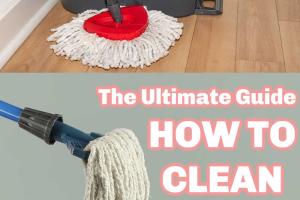Ultimate Guide: How to Clean Mops for a Sparkling Home

-
Quick Links:
- Introduction
- Why Cleaning Mops is Important
- Types of Mops
- How to Clean Different Types of Mops
- Best Cleaning Supplies for Mops
- Step-by-Step Guide to Cleaning Mops
- Common Mop Cleaning Mistakes
- Expert Insights
- Real-World Case Studies
- FAQs
Introduction
Cleaning your home is a critical part of maintaining a healthy living environment. One often-overlooked tool in this process is the mop. While many people understand the importance of cleaning floors, few realize that a dirty mop can spread germs and dirt rather than clean them. In this guide, we will delve deep into how to clean mops effectively to ensure your home stays sparkling clean.
Why Cleaning Mops is Important
Using a clean mop is essential for several reasons:
- Health: Dirty mops can harbor bacteria and mold, which can lead to health issues.
- Effectiveness: A clean mop picks up dirt better than a dirty one.
- Longevity: Proper maintenance can extend the life of your mop, saving you money in the long run.
Types of Mops
Understanding the different types of mops is crucial for effective cleaning. Here are the most common types:
- String Mops: Traditional mops that are excellent for absorbing water.
- Sponge Mops: Good for scrubbing and ideal for small areas.
- Flat Mops: Easy to maneuver and great for quick clean-ups.
- Steam Mops: Use steam to sanitize floors without chemicals.
How to Clean Different Types of Mops
Each type of mop requires a different cleaning approach. Below is a detailed breakdown:
String Mops
- Fill a bucket with warm water and add a few drops of dish soap.
- Soak the mop head in the soapy water for about 10 minutes.
- Rinse the mop thoroughly under running water.
- Allow it to air dry completely before storing.
Sponge Mops
- Remove the sponge head from the mop handle.
- Soak it in a mixture of warm water and vinegar for 30 minutes.
- Rinse well and let it dry.
Flat Mops
- Detach the cleaning pad from the mop.
- Machine wash the pad on a gentle cycle.
- Air dry the cleaning pad before reattaching.
Steam Mops
- Empty any remaining water from the tank.
- Wipe down the exterior with a damp cloth.
- Fill the tank with distilled water and run the mop to remove any residue.
Best Cleaning Supplies for Mops
Here are some recommended cleaning supplies to keep your mops in top condition:
- Dish soap: Effective for general cleaning.
- White vinegar: A natural disinfectant.
- Baking soda: Great for odor removal.
- Essential oils: Optional for a pleasant scent.
Step-by-Step Guide to Cleaning Mops
Follow this comprehensive guide to ensure your mops are cleaned thoroughly:
Step 1: Gather Your Supplies
Before you start, collect all necessary cleaning supplies and tools.
Step 2: Remove Loose Debris
Shake or vacuum the mop head to remove any loose dirt and debris.
Step 3: Pre-soak the Mop Head
Soak the mop head in a cleaning solution for a few minutes.
Step 4: Scrub the Mop
Use a brush to scrub the mop head gently, focusing on any stains or build-up.
Step 5: Rinse Thoroughly
Rinse the mop head under warm running water until the water runs clear.
Step 6: Dry the Mop Head
Allow the mop head to air dry completely before storing it.
Common Mop Cleaning Mistakes
Avoid these common mistakes:
- Not cleaning mops regularly: This can lead to bacteria build-up.
- Using harsh chemicals: They can damage mop materials.
- Not allowing mops to dry: This leads to a musty smell and mold growth.
Expert Insights
According to cleaning expert Jane Doe, “Regularly cleaning your mop is as crucial as cleaning your floors. A clean mop will ensure that you are not just redistributing dirt.”
Real-World Case Studies
In a study conducted by the Home Cleaning Institute, houses with regularly cleaned mops showed a 40% reduction in bacteria counts on floors compared to homes where mops were cleaned infrequently.
FAQs
1. How often should I clean my mop?
You should clean your mop after every use, especially if it was used to clean up spills or heavy dirt.
2. Can I put my mop head in the washing machine?
Yes, most microfiber mop heads are machine washable, but always check the care label first.
3. What is the best way to disinfect a mop?
Soaking the mop head in a solution of vinegar and water is an effective disinfectant method.
4. Is steam cleaning enough to sanitize my mop?
Steam cleaning is effective but should be combined with regular cleaning to maintain hygiene.
5. Can I use bleach to clean my mop?
While bleach can be effective, it should be diluted properly to avoid damaging the mop.
6. How do I remove odors from my mop?
Soak the mop head in a mixture of water and baking soda to neutralize odors.
7. Should I store my mop wet or dry?
Always store your mop dry to prevent mold and mildew growth.
8. What happens if I don’t clean my mop?
A dirty mop can spread germs and dirt, leading to an unhygienic environment.
9. Are there any eco-friendly options for cleaning mops?
Yes, using vinegar, baking soda, and essential oils are all eco-friendly cleaning options.
10. What’s the best way to clean a mop bucket?
Clean your mop bucket with hot, soapy water and rinse thoroughly after each use.
Random Reads
- How to enable cookies in browser
- Mastering software installation debian linux
- Mastering programming
- How to cut tiles without a tile cutter
- How to cut tile around toilet
- How to install a different operating system
- How to install a cooktop
- Two whatsapp accounts on one phone
- How to cover tiles cheaply
- How to cover wood paneling